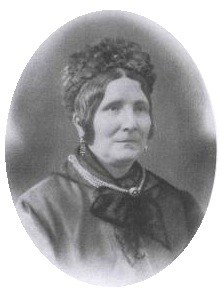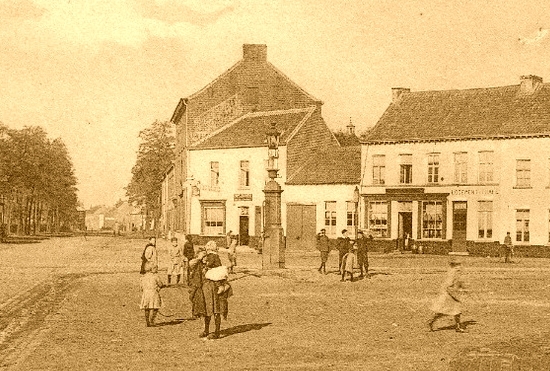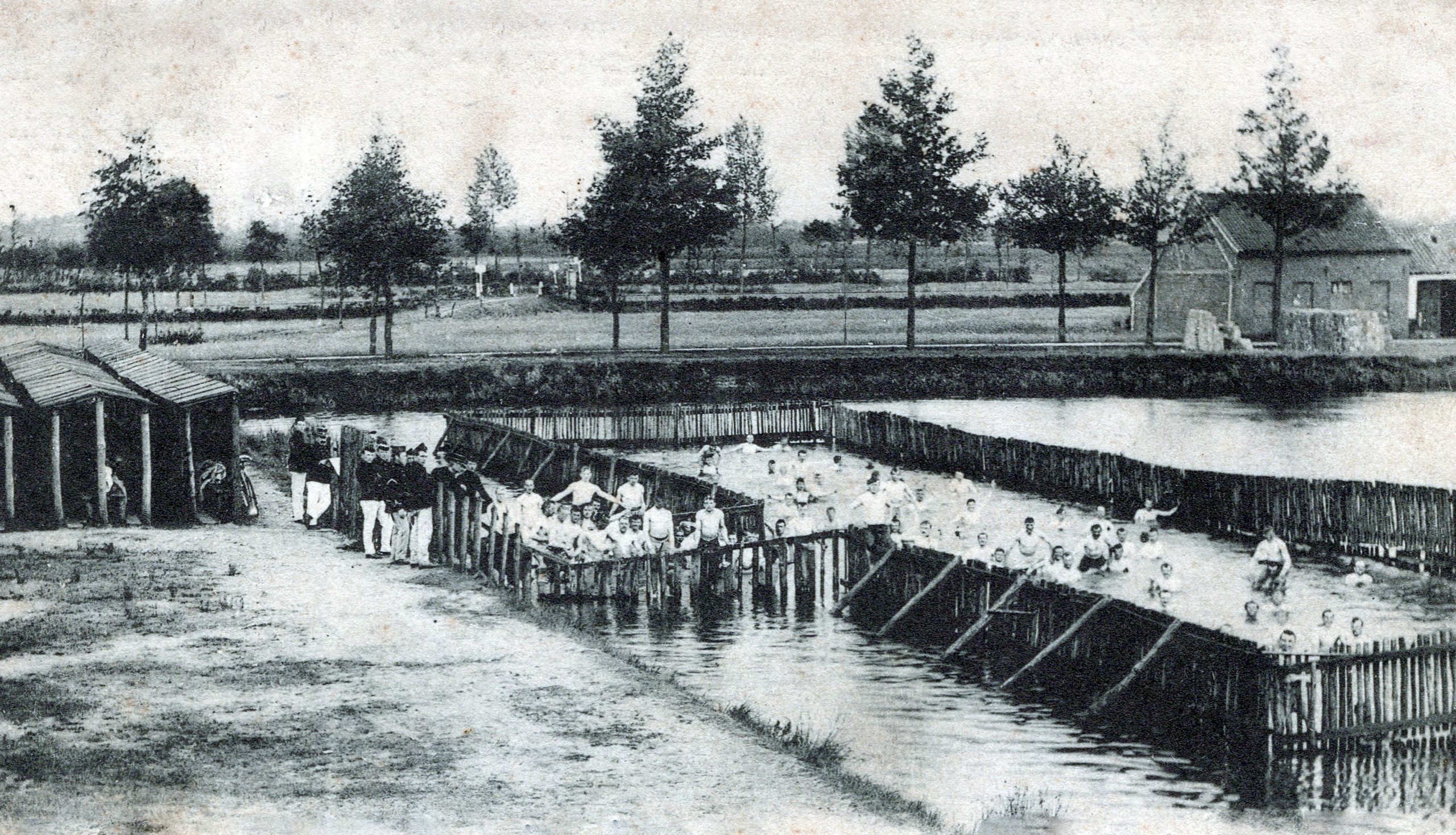The first civilians and Bourg-Léopold
The camp, that was build on the ‘Big Heath’ of Beverlo in 1835, was in the first place a pure military matter. But there is also a ancient historical law that says that military camps are an attraction to civilians who like to make some money. From the start they were contacts with the Civilians of Beverlo. They were allowed, in between the different exercises, to cut peat and to use the moorland on the ‘Big Heath’. Much more important were the civilians who established themselves close to the camp around May 1835. They came from nearly everywhere: from Diest where they used to live near the military camp, from Venlo, where since 300 years had been a military garrison, from Langdorp, Geel, from the rest of Belgium and even from France.
Immigrants from 1835
 |
 |
Caroline Uten from Diest & Jean-Baptist Apers from Puurs |
|
This colourful crowd rapidly expanded to 378 inhabitants (75 families) in 1844. Beneath them: innkeepers, blacksmiths, tailors, shoemakers, bakers, butchers, cabinetmakers, coppersmiths, wax-chandlers, slathers, woollen-drapers, glaziers… The miscellaneous derivation of these ‘”colonists’ probably led to the own nature of ‘The Camp’ (Het Kamp) and its inhabitants ( Kampenaars)!
The civilans were living near the camp in temporary wooden or or clay shacks, nearly all of them were covered with straw. The colony expanded to a little village that kept attracting new pioneers, because of all the things that were literally and figuratively there to be picked up. Because also the lead bullets from target-practise brought in money. Already in 1836 they started to build little fields and vegetable gardens for own use. Since there was adequate horse manure to make the ground fertile. Besides the vegetables could also be sold to the army, what meant an additional way to raise money.
The first centre
General Hurel tolerated that civilians established themselves on military territory (Baron François Alexander HUREL left on April 10 1841 de Belgian Army and returned to his motherland France, where he died 6 years later, in Paris, at the age of 73). His successor had it more difficult with the less honourable intentions which were disturbing the military life, and especially the moral and he decided in 1842, together with the village of Beverlo, that at the west side of the camp a new centre should come, outside the boundary of the camp. A terrain of 26 hectare was given for these means. Still a lot op pioneers choose to stay in the actual camp, close to the soldiers. To end this in 1845 no more building permits were approved and in 1848 all civil buildings in the camp were definitive cleared. On the terrain that was given by Beverlo were already an inn (1838), a postal office (1840) and a church. This ‘help-church’ (now the Chapel devoted to the H. Theresia of Lesieux / chapel of the ‘Karmelietessen’) was build next to the first graveyard in 1842-43. The existing centre was completed with a parsonage (1844) and a small school (1844).
|
The first church of Leopoldsburg (behind the kiosk) |
The first postal office of Leopoldsburg |
The present ‘head church’ O.L.V. Ten Hemelopneming (translated: Holy Mary Ascension) was build outside the centre, by and for the soldiers; you can notice this by looking at the tower and also the main gate which have as direction the military domain. Also you can see that there is only one clock in the tower. This has also the direction of the military domain (read: the different pavilions for the King, Ministers, Generals…).
|
This ‘civilian terrain’ was indicated as ‘Bourg’ in the public deed of sale and as ‘Le Bourg’ in the map of parcelling out. This map of the centre became a clear geometric shape with a well thought out pattern of a draught-board. This wasn’t unique but an occurring style in the image of time, especially to owe to considerations of health. Because of multiple epidemics in the towns at the time, people had learned that piling up people of the working class, wouldn’t be left ‘unpunished’. That’s way town planners at that time strived to making broad, long streets and large squares and esplanades. A publication of June 1842 says: ‘When building a new house, the given directions have to be followed. Furthermore the dictated base material has to be used, the indicated dimensions have to be applied and the regulations for the digging of draw-wells and water-drainage have to be observed. This was urgently necessary. On the one hand to prettify the village, on the other hand to contribute the cleanness of the buildings and streets. The last part wasn’t a success. In May 1852 the town council decided to mark every unclean house with the text: ‘forbidden house for reasons of health’. Also the parcelling out Bourg or Le Bourg was characterized by the view of construction of that time: broad, straight streets, in which big squares were foreseen for the public buildings (church and town hall). |
Church O.L.V. Ten Hemelopneming with the clock above the main gate |
From Bourg to Leopoldsburg … an evolution of 90 years
King Leopold I was closely connected to Camp Beverlo. At first he staid there regular in his ‘Royal Palais’ and was loved by the royalist population. That’s why in 1848 the name of the parcelling out ‘Bourg’ supplemented with the Kings name. Bourg-Leopold or Le Bourg Leopold, as in some deeds was mentioned, was born. In 1849 the town council of Beverlo tried to translate the name in Dutch by writing ‘Leopoldsboerg’.
Of course the heraldry of the town was also inspired by royalty, nationality and military: two crossed swords above the National tricolour, above a double ‘LL’ decorated with a crown.
|
The Koningin Astridplein (translated: Queen Astrid Square) in the seventies (130m x 90m) |
The heraldry of Leopoldsburg |
Slowly the numerous rich merchants, thanks to their trading with the army, got tired of the interfering of the municipal authorities of the distant Beverlo. They wanted an own administration, a independent town, disconnected from Beverlo. The neighbouring village Heppen, an other hamlet of Beverlo, wanted the same. Heppen was already for a long time in a ‘battle’ of emancipation. As early as September 25 1839 Heppen became by Order in Council an independent parish which enclosed and Heppen and Bourg-Leopold with the exception of the parcelling out Bourg which belonged to the parish of the army chaplain.
The joint striving was successful . By law of June 4 1850 the independent villages Bourg-Leopold (Leopoldsburg) and Heppen were born.
We have to state that the new village Bourg-Leopold at its origin in 1850 already possessed several important businesses. For instance there was the mill (yearly 400.000 kg of product) which was part of an agricultural enterprise with a gin-distillery (32.760 cans of each 1,5 litre) and a brewery (125 hl/year). Furthermore also numerous small trades, a candle-factory, a tobacco-factory, a brick-yard and a harbour at the canal could be found.
|
The mill of Leopoldsburg |
(Military) Swimming pool in the canal |
Business was doing well . In 1852 the new town council informed the provincial authority proudly that ‘the village had at least 10 merchants who made an average profit of 350.000 fr. a year’.
In 1856 the construction of the town hall in the centre of Bourg-Léopold started. On the military domain a prison was build. ‘Malakoff’, as this prison was called, was named after the bastion Sebastopol in Russia (This was the home of the detention company, also called the company ‘sans floche’). The prison was damaged by the German bombardments in May 1940 and was completely pulled down around 1950.
|
The town hall of Leopoldsburg |
The Malakoff prison |
Starting in 1875 the big exercises were no longer held in Camp Beverlo, but in the neighbourhood of Walcourt and this because of the French-German War and the insisting of the military commanders at that time. Commerce dropped because of the departure of the military. In that period numerous inhabitants left. The number of inhabitants dropped from 1871 (in 1870) to 1581 (in 1883). When in 1889 army exercises took place again in the camp, the town revived immediately. In 1899 there were 3.512 inhabitants.
From the moment the first linguistic law occurred, around 1930, the use of Dutch became obligatory in all public administration. By this Bourg-Leopold would be named Leopoldsburg from 1932.
FROM BOURG TOT LEOPOLDSBURG |
||
|
August 01 1842
|
BOURG | State Archives Hasselt |
|
1845
|
LE BOURG | Parcelling out N° 4 (State Archives Hasselt) |
|
December 02 1847
|
LE BOURG LEOPOLD | Deed notary Ceysens of Beringen (State ArchivesHasselt) |
|
June 24 1849
|
LEOPOLDSBOERG | Town Council of Beverlo (State Archives Hasselt) |
|
June 06 1850
|
BOURG-LEOPOLD | Belgian Statute Book – Law of June 06 1850 |
|
June 14 1932
|
LEOPOLDSBURG | Official translation |
 |
||
This article is also available in
![]() Nederlands
Nederlands









